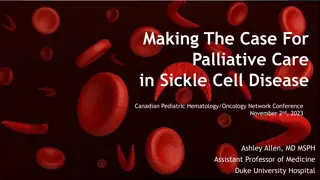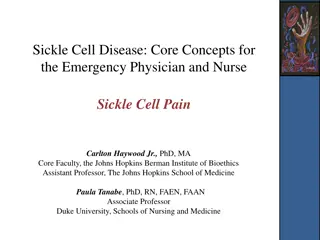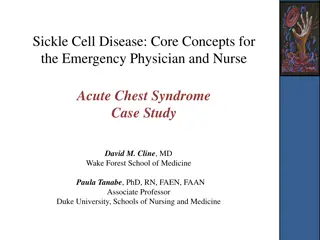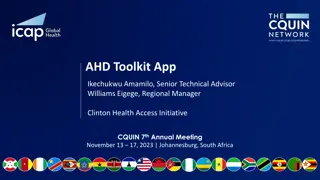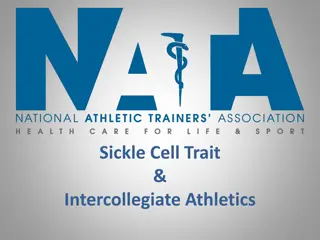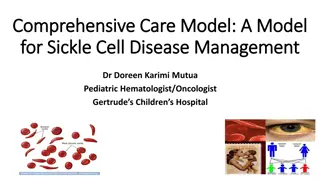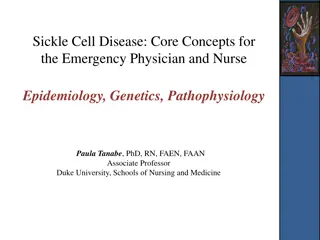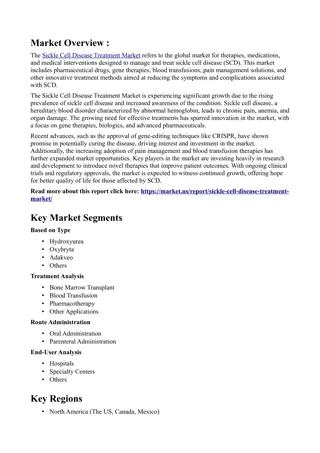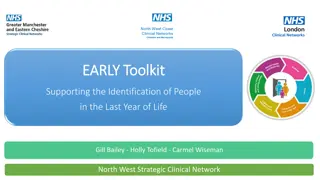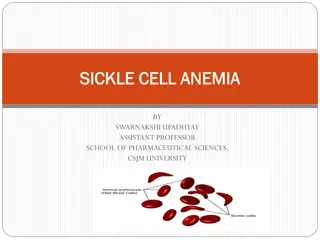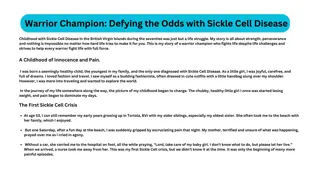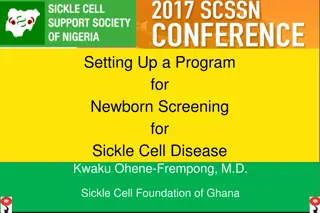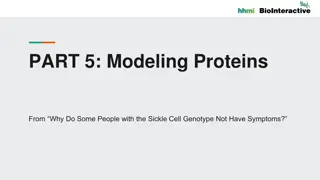Can You Tell It's Sickle Cell? Comms Toolkit
A campaign by NHS England and NHS Improvement to raise awareness of the signs and symptoms of Sickle Cell crisis among urgent emergency care staff and individuals living with the condition. The campaign also promotes uptake of an e-learning module on Sickle Cell and healthcare inequalities.
Download Presentation

Please find below an Image/Link to download the presentation.
The content on the website is provided AS IS for your information and personal use only. It may not be sold, licensed, or shared on other websites without obtaining consent from the author.If you encounter any issues during the download, it is possible that the publisher has removed the file from their server.
You are allowed to download the files provided on this website for personal or commercial use, subject to the condition that they are used lawfully. All files are the property of their respective owners.
The content on the website is provided AS IS for your information and personal use only. It may not be sold, licensed, or shared on other websites without obtaining consent from the author.
E N D
Presentation Transcript
Can you tell its Sickle Cell? comms toolkit
What is the campaign? Overview NHS England and NHS Improvement is continuing it s Sickle Cell awareness campaign ahead of World Sickle Cell Day 2023. Objectives/Aims The campaign, which is part of a bigger drive to improve sickle cell care across the NHS, aims to increase awareness of the key signs and symptoms of a Sickle Cell crisis, particularly among urgent emergency care staff and those living with the condition and their carers. It also aims to promote and generate uptake of a new e- learning module about the condition and the healthcare inequalities related to it.
Audience Audience(s) NHS Urgent Emergency Care staff GPs, Practice Nurses Other primary care staff People living with Sickle Cell disease / carers / wider communities
Key messages Key messages NHS England and NHS Improvement is launching a new Sickle Cell awareness campaign ahead of World Sickle Cell Day 2022 The campaign, which is part of a bigger drive to improve sickle cell care across the NHS, aims to increase awareness of the key signs and symptoms of a Sickle Cell crisis, particularly among urgent emergency care staff and those living with the condition and their carers. Anyone can be born with Sickle Cell disorder, but it is most common amongst people from a black Caribbean or black African background If a person has any of these symptoms, immediate action should be taken as they could be signs of a Sickle Cell crisis or complication: Pain Signs of infection including fever One-sided paralysis or weakness in the face, arms or legs Confusion Difficulty walking or talking Sudden visual changes Unexplained numbness Severe headache Breathlessness, chest pain or low oxygen levels
Key messages Key messages continued Acting quickly can save lives If someone has these symptoms, they should seek urgent medical attention this may be via A&E, 999 or their local haematology unit and should be treated immediately. Patients admitted to the hospital for sickle cell complications should be referred promptly to and treated by haematologists or clinicians with expertise in sickle cell disorders A training module for NHS staff is available to support increased knowledge of the condition and how to treat it. The training module also includes information on healthcare inequalities related to the condition: https://www.e-lfh.org.uk/programmes/health-inequalities/ Call to action If someone has symptoms of a crisis, they should seek urgent medical attention this may be via A&E, 999 or their local haematology unit and should be treated immediately. NHS staff can complete a free e-learning module to support increased knowledge of the condition and how to treat it. The training module also includes information on healthcare inequalities related to the condition: https://www.e-lfh.org.uk/programmes/health-inequalities/ Are there regionalised messages? Regions can include local stats on patients living with Sickle Cell, especially London and other high black Caribbean/African-populated areas.
New messages for 2023 Key messages New for 2023 (embargoed until 19 June 2023) On World Sickle Cell Day 2023, NHS England has announced it will open up to six new clinics to provide thousands of people with sickle cell disease pain relief when they suffer a life-threatening crisis. The new Hyperacute Units funded by the NHS will be set up in parts of the country with the highest number of sickle cell patients including London, Birmingham and Manchester by the end of 2023. NHS England is also committing to ensuring every person living with sickle cell has access to a digital care plan. This will allow healthcare professionals to access a patient s care plan thus enabling seamless care. From June 2023, patients will also be given a card to help identify them as a sickle cell patient and speed up access to appropriate support when they attend A&E.
Key messages Secondary messages Sickle cell disorder is the name for a group of inherited red blood cell disorders. The most serious type is called sickle cell anaemia. People with sickle cell disease produce unusually shaped red blood cells that can cause excruciating pain and other problems because they do not live as long as healthy blood cells and can block blood vessels. Sickle cell disorder is a serious and lifelong health condition, although treatment can help manage many of the symptoms, reduce organ damage and prolong life. Painful episodes are referred to as sickle cell crises. Treatment includes strong painkillers such as morphine to control the pain, intravenous fluids and oxygen. All patients presenting with acute sickle pain should receive initial analgesia within 30 minutes and have achieved good pain relief within two hours. Over half of sickle cell disease patients living in the most deprived areas experience re-admission to hospital in comparison with 28% among those hospitalised from the least deprived areas. Sickle cell patients admitted from the most deprived areas are twice as likely to die in hospital in comparison with those admitted from the least deprived areas. The campaign aims to reach these areas as a priority.
Top three ways to help Share our messages on social media, email and staff intranets especially encouraging staff to complete the new e-learning module. Think about profiling staff that have completed the module and/or work in the treatment of Sickle Cell Download campaign materials from the Campaign Resource Centre and share with colleagues, local communications networks, community organisations etc Produce localised media releases include local stats about people living with Sickle Cell in your area, what you are doing locally to improve care for people with Sickle Cell, local relevant spokespeople encouraging staff to complete the e-learning module
Resources to use You can find all resources on the Campaign Resource Centre Resources include: - - - - - - Social media graphics Posters and leaflets Pull-up banners Patient card Digital screens Email signatures
Example social media posts Example posts for Twitter Know the signs of a Sickle Cell crisis: Pain Signs of infection One-sided paralysis/weakness Confusion Difficulty walking/talking Sudden visual changes Unexplained numbness Severe headache Breathlessness Acting quickly can save lives. #CanYouTellItsSickleCell Always up-to-date image size guide for Twitter can be found here
Example social media posts Example posts for Twitter e-learning module Know the signs of a Sickle Cell crisis. Complete the free e-learning module covering symptoms, how to treat it and the healthcare inequalities related to the condition. www.e-lfh.org.uk/programmes/health- inequalities Acting quickly can save lives. #CanYouTellItsSickleCell Always up-to-date image size guide for Twitter can be found here
Example social media posts More example posts for Twitter Tweet for staff A free e-learning module has been created for NHS Staff, helping you to act fast and save lives. This covers symptoms, treatment and healthcare inequalities experienced by people with the condition. Link: www.e-lfh.org.uk/programmes/health-inequalities #CanYouTellItsSickleCell Tweet for patients/public If someone is having a sickle cell crisis, acting fast saves lives. That s why we re training NHS staff to recognise the signs and symptoms of a crisis, know how to treat patients and address the healthcare inequalities related to the condition. #CanYouTellItsSickleCell Always up-to-date image size guide for Twitter can be found here
Example social media posts Example posts for LinkedIn Know the signs of a Sickle Cell crisis: Pain Signs of infection One-sided paralysis/weakness Confusion Difficulty walking/talking Sudden visual changes Unexplained numbness Severe headache Breathlessness Complete the free e-learning module on sickle cell at: https://www.e-lfh.org.uk/programmes/health-inequalities/ #CanYouTellItsSickleCell Always up-to-date image size guide for LinkedIn can be found here.
Example long copy (c. 250 words) This can be used for bulletins/websites/press releases, depending on your activity. NHS England is continuing its Sickle Cell awareness campaign for World Sickle Cell Day 2023. The campaign, which is part of a bigger drive to improve sickle cell care across the NHS, aims to increase awareness of the key signs and symptoms of a Sickle Cell crisis, particularly among urgent emergency care staff and those living with the condition and their carers. Anyone can be born with Sickle Cell disorder, but it is most common amongst people from a black Caribbean or black African background If a person has any of these symptoms, immediate action should be taken as they could be signs of a Sickle Cell crisis or complication: Pain Signs of infection including fever One-sided paralysis or weakness in the face, arms or legs Confusion Difficulty walking or talking Sudden visual changes Unexplained numbness Severe headache Breathlessness, chest pain or low oxygen levels Acting quickly can save lives. If someone has these symptoms, they should seek urgent medical attention this may be via A&E, 999 or their local haematology unit and should be treated immediately. Patients admitted to the hospital for sickle cell complications should be referred promptly to and treated by haematologists or clinicians with expertise in sickle cell disorders A training module for NHS staff is available to support increased knowledge of the condition and how to treat it. The training module also includes information on healthcare inequalities related to the condition: https://www.e-lfh.org.uk/programmes/health-inequalities/
Example short copy (c. 100 words) This can be used for bulletins/websites/press releases, depending on your activity. NHS England is raising awareness of the key signs and symptoms of a Sickle Cell crisis for World Sickle Cell Day 2023, particularly among urgent emergency care staff and those living with the condition and their carers. If someone has these symptoms, they should seek urgent medical attention: Pain Signs of infection including fever One-sided paralysis or weakness in the face, arms or legs Confusion Difficulty walking or talking Sudden visual changes Unexplained numbness Severe headache Breathlessness, chest pain or low oxygen levels Acting quickly can save lives. A training module for NHS staff includes signs of a crisis, how to treat it and information on healthcare inequalities related to the condition: https://www.e- lfh.org.uk/programmes/health-inequalities/
Example short copy (c. 100 words) CALL TO ACTION COPY FOR UEC / OTHER RELEVANT ROLES: This can be used for bulletins/websites/press releases, depending on your activity. Acting quickly can save lives; make sure you know how to respond in a Sickle Cell crisis situation. Complete the FREE online training now at: : https://www.e-lfh.org.uk/programmes/health-inequalities/ . If someone has these symptoms, they should receive urgent medical attention: Pain Signs of infection including fever One-sided paralysis or weakness in the face, arms or legs Confusion Difficulty walking or talking Sudden visual changes Unexplained numbness Severe headache Breathlessness, chest pain or low oxygen levels Acting quickly can save lives.
Get in touch! Send feedback and questions or let us know how your activity performed by email to the Healthcare Inequalities Improvement comms team at: england.hicomms@nhs.net



